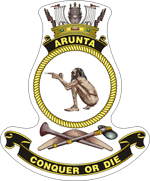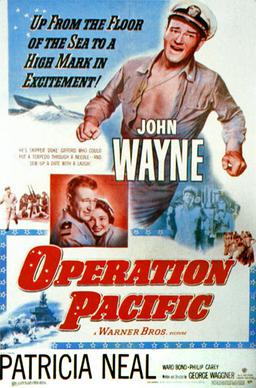
Donovan's Reef is a 1963 American adventure comedy film starring John Wayne and Lee Marvin. It was directed by John Ford and filmed in Kauai, Hawaii, but is set in French Polynesia.

Julia Jean "Lana" Turner was an American actress. Over a career spanning nearly five decades, she achieved fame as both a pin-up model and a film actress, as well as for her highly publicized personal life. In the mid-1940s, she was one of the highest-paid American actresses and one of MGM's biggest stars, with her films earning more than $50 million for the studio during her 18-year contract with them. Turner is frequently cited as a popular culture icon of Hollywood glamour and a screen legend of classical Hollywood cinema. She was nominated for numerous awards.

HMAS Napier (G97/D13) was an N-class destroyer serving in the Royal Australian Navy (RAN) during World War II. Built during 1939 and 1940, the destroyer was commissioned into the RAN, although she was ordered and owned by the British government. During 1941, Napier operated in the Mediterranean, before being transferred to the British Eastern Fleet at the start of 1942, then to south Atlantic operations in early 1944. In 1945, Napier was assigned to the British Pacific Fleet, and spent the rest of World War II in the fight against Japan. After the war's end, the destroyer was decommissioned and returned to the British. She was sold off in 1955, and broken up in 1956.

HMAS Nepal (G25/D14) was an N-class destroyer of the Royal Australian Navy (RAN). Launched in 1941 as Norseman, the ship suffered significant damage during an air raid on the John I. Thornycroft and Company shipyard, and during repairs was renamed to recognise Nepal's contribution to the British war effort. Although commissioned into the RAN in 1942, the ship remained the property of the Royal Navy.

HMAS Nizam (G38/D15) was an N-class destroyer of the Royal Australian Navy (RAN). The destroyer, named after Osman Ali Khan, the last Nizam of Hyderabad, was commissioned into the RAN in 1940, although the ship remained the property of the Royal Navy for her entire career.

HMS Courageous was the lead ship of her class of three battlecruisers built for the Royal Navy in the First World War. Designed to support the Baltic Project championed by First Sea Lord John Fisher, the ship was very lightly armoured and armed with only a few heavy guns. Courageous was completed in late 1916 and spent the war patrolling the North Sea. She participated in the Second Battle of Heligoland Bight in November 1917 and was present when the German High Seas Fleet surrendered a year later.

The Flower-class corvette was a British class of 294 corvettes used during World War II by the Allied navies particularly as anti-submarine convoy escorts in the Battle of the Atlantic. Royal Navy ships of this class were named after flowers.

HMAS Arunta (I30/D5/D130) was a Tribal-class destroyer of the Royal Australian Navy (RAN). Named for the Arrernte Aboriginal peoples, the destroyer was laid down in 1939 and commissioned into the RAN in 1942.

Operation Pacific is a 1951 black-and-white World War II submarine war drama from Warner Bros. Pictures, produced by Louis Edelman, and written as well as directed by George Waggner. John Wayne and Patricia Neal star and Ward Bond and Philip Carey play supporting roles.

The River class was a class of 151 frigates launched between 1941 and 1944 for use as anti-submarine convoy escorts in the North Atlantic. The majority served with the Royal Navy and Royal Canadian Navy (RCN), with some serving in the other Allied navies: the Royal Australian Navy (RAN), the Free French Naval Forces, the Royal Netherlands Navy and, post-war, the South African Navy.

The Cruel Sea is a 1953 British war film based on the novel of the same title by Nicholas Monsarrat. The film starred Jack Hawkins, Donald Sinden, Denholm Elliott, Stanley Baker, Liam Redmond, Virginia McKenna and Moira Lister. The movie was made by Ealing Studios seven years after the end of the Second World War, and was directed by Charles Frend and produced by Leslie Norman.

John Villiers Farrow, KGCHS was an Australian film director, producer, and screenwriter. Spending a considerable amount of his career in the United States, in 1942 he was nominated for the Academy Award for Best Director for Wake Island, and in 1957 he won the Academy Award for Best Adapted Screenplay for Around the World in Eighty Days. He had seven children by his wife, actress Maureen O'Sullivan, including actress Mia Farrow.

Task Force is a 1949 American war film filmed in black-and-white with some Technicolor sequences about the development of U.S. aircraft carriers from USS Langley (CV-1) to USS Franklin (CV-13). Although Robert Montgomery was originally considered for the leading role, the film stars Gary Cooper, Jane Wyatt, Walter Brennan, Wayne Morris, Julie London and Jack Holt. Task Force was the only film Gary Cooper and Jane Wyatt made together, and was the last of the eight films Cooper and Walter Brennan made together. The U.S. Navy provided complete support in not only lending naval vessels and facilities, but also allowed the use of archival footage of the development of naval air power.

HMS Sussex was one of the London sub-class of the County-class heavy cruisers in the Royal Navy. She was laid down by R. and W. Hawthorn, Leslie and Company, Limited, at Hebburn-on-Tyne on 1 February 1927, launched on 22 February 1928 and completed on 19 March 1929.

HMAS Vendetta (D69/I69) was a V-class destroyer that served in the Royal Navy and the Royal Australian Navy (RAN). One of 25 V class ships ordered for the Royal Navy during World War I, Vendetta entered service in 1917.

HMS Diomede was a Danae-class cruiser of the Royal Navy. Constructed at Vickers Armstrong, Barrow, she was constructed too late to take part in World War I and was completed at the Royal Dockyard, Portsmouth. Between the wars, she served on the China Station, Pacific waters, East Indies Waters and from 1936 onwards, in reserve. In World War II she performed four years of arduous war duty, during which time she captured the crew of the German blockade runner Idarwald after she had chased that ship and when the crew scuttled Idarwald. Between 22 July 1942 and 24 September 1943 she was converted to a training ship at Rosyth Dockyard. In 1945 she was placed in reserve and scrapped a year later.

John Paul Jones is a 1959 biographical adventure film from Warner Bros. Pictures, filmed in the Technirama process, about the American Revolutionary War naval hero. The film, shot in Dénia, Spain, was produced by Samuel Bronston and directed by John Farrow, from a screenplay by John Farrow, Ben Hecht, and Jesse Lasky Jr. The film is based on the story Nor'wester by Clements Ripley. The music score was by Max Steiner and the cinematography was by Michel Kelber. It was the final film directed by Farrow.

SMS Möwe was a merchant raider of the Imperial German Navy which operated against Allied shipping during World War I.
La Classe américaine, also known as Le Grand Détournement, is a 1993 French television film, written and directed by Michel Hazanavicius and Dominique Mézerette. It consists exclusively of extracts of old Warner Bros. films, put together and dubbed with new lines so as to create an entirely new film that is a parody of Citizen Kane.

The Navy Comes Through is a 1942 American World War II film directed by A. Edward Sutherland. It stars Pat O'Brien, George Murphy and Jane Wyatt. Vernon L. Walker and James G. Stewart were nominated for an Oscar for Best Special Effects. The film was based on Borden Chase's 1939 short story "Pay to Learn". The working titles of the film were Pay to Learn and Battle Stations. The film was the first RKO Pictures use of a new radio signal trademark that spelled out the word "victory." Prior to this, the studio's radio signal trademark spelled out "RKO."



















